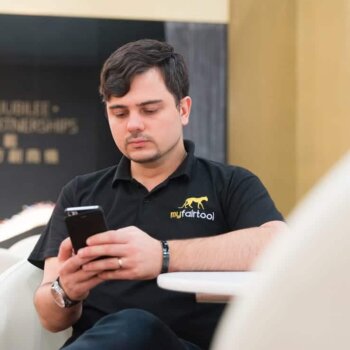All great startups start off with an idea followed by years of hard work. So how do you evaluate quickly and efficiently whether the idea merits further investment of your time and money? The following article describes the process that we have seen play out with great success for the companies we have been working with over the last 2.5 years.
Key takeaways
- Quickly recognise your assumptions by using a Lean Canvas;
- Interviewing and observation help test key assumptions quickly and develop your product instincts;
- Create a well-designed but minimal digital product to test out the key value proposition.
Steps to evaluating your startup idea
Over the last 2.5 years we have worked with a number of founders who have all had a startup idea and needed help in turning it into a valuable business over the 12 months we worked with them. We have refined the first few months into a process that is fairly consistent in its approach (especially for ecommerce and marketplace businesses) and it has proven really effective in assessing whether the idea is going to fly or not over the rest of the year.
1. Stay objective.
All founders fall foul of “Confirmation Bias” to a greater or lesser degree, but it’s really important to understand that in this super early phase you need to be super flexible deciding if this idea is worth pursuing. The worst situation is to end up investing a lot time building a product for a weak idea. Once you move into a phase of execution it becomes harder and harder to change direction so it is far better to be open minded now and alter the idea if a bigger truth comes along in this evaluation phase.
2. Use the Lean Canvas to identify your assumptions
Before we invest in any idea stage companies we ask the founders to create a Lean Canvas (similar to a business model canvas but more designed for startups). Below is an example of a lean canvas when we first were evaluating Lexoo an online legal marketplace (thanks to the Lexoo team for letting us share this).
3. Identify your assumptions
Now that you have filled out the canvas as best as you can, go and find some friends (preferably with some business/startup experience) and on a whiteboard and draw the following chart.
Spend 15 minutes on each of the 9 sections of the canvas and ask yourself what assumptions you have made about the business. Write down all the assumptions and how you would test them on post-it notes and categorise them by how easy they are to test and how critical they are to the business succeeding.
Below is an example of a few of Lexoo’s post-it notes on the chart as an example.
This exercise will give you an ordered list of assumptions and ways you can test them based on importance and ease. We have found that assumptions around whether users want this service or product are usually the most important and can be easily tested through speaking to users to understand their needs. The hardest assumptions to test are often to do with how the business will perform at scale (where market sizing and looking at parallels can help).
4. Test your assumptions around the problem, customers, and existing solutions
All startups are trying to solve a problem/aspiration of some kind. Some problems are clearly felt but for others your potential users may never articulate them clearly (because they didn’t know it was possible to improve on how they are currently doing things).
“Don’t ask your potential users what they want. It’s your job as a founder to figure that out based on your deep understanding of their unmet needs and your knowledge of what is possible”
However, through interviews and observations you should be able to see strong evidence of them struggling to solve their problem or solving it in a way that you know you can significantly improve upon. We recommend interviewing at least 20-40 users of different types in order to do some early validation around the problem, your customers and existing solutions. It is also a great idea to observe people as they try to solve these problems and also to try to solve it yourself using existing solutions.
Not only does the process of interviews and observations give you a sense of whether you are onto a good idea and validate your key assumptions around the problem to be solved, but it also will give you a wealth of more nuanced information that will inform your product solution.
“Sometimes I work with founders that are reluctant to invest any time in learning about their potential users before building their product. They usually have a hard time.”
If you don’t see a strong need through this process then you should really think about whether it is a good idea.
5. Testing your unique value proposition and solution
Once you are confident that you are solving a problem the usual next set of assumptions you want to test are whether your target market will respond to your unique value proposition and solution. How you go about testing this depends on the product and business type. For consumer companies we usually create a homepage with a call to action that requires some commitment from the user (however big or small that is) and for more complicated products (Saas or mobile) we have built prototypes and observed users interact with them to understand if we are providing value. For hardware products a lot of companies will run a Kickstarter or Indiegogo campaign to prove need (and get funding for the first production run). Dropbox (a very complicated product) famously used a video to explain what they did to prove their solution was what people wanted.
If you are building a homepage test then it is important that it clearly describes what you are offering and that is beautifully presented. Users expectations of consumer products in terms of design are always increasing, so if your product isn’t doesn’t look professional then your users may not engage and you may come to the wrong conclusion. With tools like Strikingly or QuickMVP or a few days from a designer and front-end developer you should have something that looks and feels professional. Below is an example of the homepage that we used with Lexoo that also had a simple form for the users to fill out with what they wanted the lawyer to help them with.
6. Testing marketing channels
Great startups are created through great products and a relentless focus on growth (and good good unit economics for the most part!). For consumer companies, paid marketing is probably going to be part of the mix so it is important to drive some users to your service to test your proposition to get a baseline of cost and volumes that you can expect from channels like search, facebook or twitter. We usually see CAC to be way higher in the beginning but also see it reduce quite rapidly over the 12 months through campaign and product optimisations. Obviously if it is extremely high then that is a warning signal you should pay attention as your unit economics might not work. Volume is also important as it helps you understand how quickly you will need to invest in offline marketing channels and PR in the early stages.
By driving users to your homepage test you will be able to see whether users engage and start to test some assumptions about your marketing strategies.
7a Test value and revenue in an unscaleable way through a concierge service
Using a concierge style service on top of a thin product is a great way to test the real value you want to provide quickly. You can use manual effort to fill out the steps you one day hope to automate. Not only will you have very happy customers from day one but you will also get a deeper understanding of what you need to build to keep them happy. Marketplaces and ecommerce lend themselves very well to this technique, as do a lot of startups that use intelligent systems to offer a personalised service.
Lexoo did this by manually matching lawyers to jobs and sent lawyer profiles to customers via email. Over time they built more product to automate some of the process to get it to scale while keeping the same level of personal service.
“Use the concierge service not only to test you are offering value but also to have more face to face conversations with your users and deepen your understanding of their needs.”
7b Test value using prototypes
For SaaS and more complicated products you will generally need to build more product before you can know if you are providing value. In these cases we prefer testing that value through prototypes. It is not as powerful as the concierge service but you can still learn a lot quickly before committing to building something. Running design sprints is a great way to rapidly test out a product or feature and is a great way for the whole team and customers to provide input.
8 Keep learning more about your customers at all times
This last one really isn’t a specific step in the process but is the underlying principle to what you should be doing while evaluating your idea. In the 4-8 weeks you may spend on this (depending on how well everything goes) you will continue to understand more and more about your users. Be sure to email every customer, give them phone numbers to call you, add live chat on the site and organise user tests (online and in person). It is only through a really deep understanding of your customers that you can then move onto the next phase of building a product that really resonates.
This article was written by Dharmesh Raithatha. see more.
































